The melancholy and other sadnesses: an interaction between literary works and medical treaties: (16th-18th centuries)
Main Article Content
A review is made of the use of the concept melancholy and the associated conditions, such as hypochondria and spleen, between the 16th and 18th centuries, both technical or scientific texts and in literary texts, highlighting the dialogue between them. Melancholy referred to a wide spectrum of conditions, and that's how it was used in the literature, its current association with depressive disorders is late, but it is the one that will cause more texts in the 18th century. It is identified how the literature appropriated psychopathology developments to create characters that in turn were the starting point for medical and psychological theorizing. It is noted that the intertextuality exercises are pedagogical tools, relevant both for the teaching of the disciplines and for research.
- hypochondria
- intertextuality
- literature
- melancholy
- psychopathology
- spleen
Berti, Eduardo. “Breve Historia del Spleen”. El Malpensante. 85. 2008: 40-45. Impreso.
Bloom, Harold. “Freud: Una lectura shakespeareana”. Nexos. 1995. Web. https://www.nexos.com.mx/?p=7521.
Bloom, Harold. Genios, un mosaico de cien mentes creativas y ejemplares. Barcelona: Editorial Anagrama, 2012. Impreso.
Borges, Jorge Luis. Introducción a la Literatura Inglesa. Madrid: Alianza Editorial S. A., 1999. Impreso.
Baur, Susan. Hypochondria Woeful Imaginings. Berkeley: University of California Press, 1989. Impreso.
Benjamin, Walter. “El origen del Trauerspiel alemán”. Obras Libro I/Volumen 1. Madrid: Abada Editores, 2006. Impreso.
Berlin, Isaiah. Las raíces del romanticismo. Buenos Aires: Taurus, 2015. Impreso.
Berrios, Germán. Historia de los síntomas de los trastornos mentales. La Psicopatología descriptiva desde el siglo XIX. México: Fondo de Cultura Económica, 2013. Impreso.
Burton, Robert (Democritus Junior). The Anatomy of Melancholy (1621). Project Gutemberg, eBook, 2004.
Carlton, William John. Timothe Bright Doctor of Phisicke. London: Elliot Stock, 1911. Web. //archive.org/details/cu31924029486143.
Cervantes, Miguel. Don Quijote de la Mancha. España: Real Academia Española Asociación de Academias de la Lengua Española (edición del cuarto centenario), 2004. Impreso.
Cheyne, George. The English Malady, or a Treatise of Nervous Diseases of all Kinds, as Spleen, Vapours, Lowness of Spirits, Hypochondriacal, and Hysterical Distempers, etc. London: G. Strahan, London, 1733. Impreso.
Climacus, John (St). The Ladder of Divine Ascent. New York: Paulist Press, 1982. Impreso.
Cowper, William. The task and other poems. The Project Gutemberg, eBook, 2001.
Davies, Laura. “Boswell in London: An Eighteenth-Century Soundscape Study”. Études Épistémè. 29, 2019. Web. 2020. http://journals.openedition.org/episteme/1046.
De Ávila, Teresa. “Las Moradas” (1557). Catholic.net. Web. http://es.catholic.net/catholic_db/archivosWord_db/las_moradas_teresa_de_avila.pdf.
De Ávila, Teresa. “Las Fundaciones” (1573-1582). Portal Carmelitano. Web. http://www.portalcarmelitano.org/component/k2/item/581-las-fundaciones-de-santa-teresa-de-jes%C3%BAs-%7C-pdf.html.
Diderot, Denis. “Jacques le Fataliste et son Maître”. Texte établi par J. Assézat et M. Tourneux, Garnier, 1875-77. Wikisourse. Web. http://fr.wikisource.org/wiki/Jacques_le_fataliste_et_son_ma%C3%AEtre.
Foucault, Michael. Historia de la locura en la época clásica. Bogotá: Fondo de Cultura Económica, 1993. Impreso.
Freud, Sigmund. La interpretación de los sueños (1900). Obras Completas, tomo I. Madrid: Editorial Biblioteca Nueva, 1985. Impreso.
Galeno. Sobre la localización de las enfermedades. Madrid: Editorial Gredos, 1997. Impreso.
Genette, Gerard. Palimpsestos. La literatura en segundo grado. Madrid: Taurus, 1989. Impreso.
Glas, Gerrit. “A conceptual history of anxiety and depression”. Eds. J. A. den Boer & A. Sitsen. Handbook on Anxiety and Depression. New York/Basel/Hong Kong: Marcel Dekker, 2003. 1-48. Impreso.
Ingram, Allan y Sim Stuart. Introduction: Depression before Depression. Melancholy Experience in Literature of the Long Eighteenth Century. Ingram A., Sim S., Lawlor C., Terry R., Baker J. & Wetherall-Dickson L. London: Palgrave Macmillan, 2011. Impreso.
Leblanc, Jean Bernard. Lettres d'un François. Tome premier, Néaulme. Lyon: Collège de la Sainte Trinité de la Compagnie de Jésus, 1745. Impreso.
Lewis, Matthew Gregory. The Monk; a romance. The Project Gutenberg, e-book, 2008.
Kendel, Robert E. “William Cullen's bicentenary”. Psychiatric Bulletin. 15, 1991: 32-33. Impreso.
Klibansky, Raymond, Panofsky, Erwin y Saxl Fritz. Saturno y la melancolía. Madrid: Alianza Editorial, 2004. Impreso.
Milton, John. “L'Allegro / Il Penseroso”. Editorial Alastor. Web. 2012. http://editorial-alastor.blogspot.com/2012/03/john-milton-lallegro-il-penseroso.html.
Morris, David. “The Marquis de Sade and the Discourses of Pain:
Literature and Medicine at the Revolution”. The Languages of Psyche, Mind and Body in Enlightenment Thought. Ed. Rousseau G. S. Berkeley and Los Angeles: University of California Press, University of California Press, 1991. Impreso.
Ober, Willian B. “Johnson and Boswell: ‘Vile melancholy’ and ‘the hypochondriack’”. Bull. N. Y. Acad. Med. 61, 7.1985. Impreso.
Pinel, Philippe. “Traité Medico Philosophique sur l'aliénation mentale”. Paris: J. A. Brosson, 1809. Gallica. Web. http://visualiseur.bnf.fr/Visualiseur?Destination=Gallica&O=NUMM-76576.
Porter, Roy. Barely Touching: A Social Perspective on Mind and Body, en The Languages of Psyche, Mind and Body in Enlightenment Thought. Ed. Rousseau G. S. Berkeley and Los Angeles: University of California Press, University of California Press, 1991. Impreso.
Pott, Heleen. “Why bad Moods Matter. William James on Melancholy, Mystic Emotion, and the Meaning of Life”. Philosophia. 45, 2017: 1635-1645. Impreso.
Pottle, Frederick A. James Boswell, the Earlier Years, 1740-1769. New York: McGraw-Hill, 1966. Impreso.
Rivera Salazar, José Luis, Murillo Villa, Jacobo Axel y Miguel Ángel Sierra Rubio. El concepto de neurosis de William Cullen como revolución científica. Enseñanza e Investigación en Psicología. 12, 1, 2007: 157-178. Impreso.
Rousseau, G. S. y Roy Porter. “Toward a Natural History of Mind and Body”. The Languages of Psyche, Mind and Body in Enlightenment Thought. Ed. Rousseau G. S. Berkeley and Los Angeles: University of California Press, University of California Press, 1991. Impreso.
Shakespeare, William. “The Tragedie of Hamlet”. Open Source Shakespeare. Web. https://www.opensourceshakespeare.org/views/plays/play_view.php?WorkID=hamlet&Scope=entire&pleasewait=1&msg=pl.
Townshend, Dale. The Gothic World. New York: Glennis Byron & Dale Townshend, Routledge, 2014. Impreso.
Watt, Ian. The Rise of the Novel: Studies in Defoe, Richardson and Fielding. Berkeley and Los Angeles: University of California Press, 2001. Impreso.
Willis, Thomas. Two Discourses concerning the Soul of Brutes. London: Dring, Harper, and Leigh, 1683.
Wilson, John Dover. What Happens in Hamlet. New York: Macmillan, 1935. Impreso.
Downloads

This work is licensed under a Creative Commons Attribution-NonCommercial-NoDerivatives 4.0 International License.





